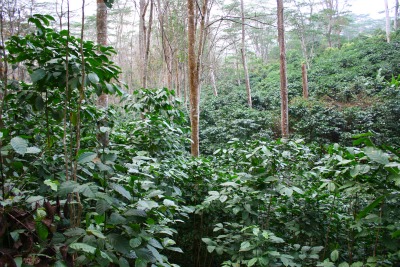Options and Levers
A possible first step was to reduce or eliminate rice imports. It was costly anyway, given rising world rice prices. [17] Phasing out imports, however, would not be simple. For example, should Timor-Leste begin to lower the volume of imports immediately, or stagger the reductions to take effect only after domestic yields increased? Timing was important: continuing to import and distribute at current levels as yields increased could saturate or flood the rice market, driving domestic rice prices even lower—good for consumers but potentially disastrous for farmers. But reducing imports too soon ran the risk of a rice shortage if yield increases faltered. As an interim measure, the country might try a futures contract—buy a predefined amount of rice at a set price, delivered at a specific date in the future. This was one way to stave off anticipated price hikes and buy the country some time to boost local production. But how reliable were the futures markets?

A coffee plantation
Another policy option was to remove the consumption subsidy. But this was risky as well. The subsidy provided a safety net to households who otherwise could not afford rice. Agriculture officials would need to balance the needs of rice consumers against the need to give rice producers a sufficiently high farmgate price to make their agribusinesses profitable.
Spend above ESI? The government could choose to invest in domestic production while maintaining the current import-and-subsidy system. That route, however, would require the treasury to spend even more above ESI than it had been doing. The administration had already come under fire from vocal and influential members of Timorese civil society for exceeding the ESI threshold. For instance, a Timor-Leste NGO, L’ao Hamutuk, said that it “believes saving the people's money is better than wasting it, and we do not encourage rapid spending without planning or results.” [18]
Other models? Another choice was to maintain subsidies, but transfer those subsidies to producers for the purchase of inputs rather than consumers for the purchase of the end product. One subsidy program, piloted in Malawi, might be a model for Timor-Leste. It provided farmers with vouchers to purchase inputs at a fraction of the market price. [19] As with any input subsidy program, however, there was a risk of cross-border leakages and the emergence of secondary (or “black”) markets. [20] So another option was simply to give farmers cash and let them choose what do with the money. A revolving seed system, such as the one used by the not-for-profit Mercy Corps in Timor-Leste, offered yet another option. Mercy Corps gave a group of farmers seeds on the condition that they return to Mercy Corps the same amount of seed after harvest; the new seed in turn was given to another group of farmers for the next planting season. Perhaps this could be replicated at a national level.
Budgetary constraints. Whether the money came from the Petroleum Fund or elsewhere, however, the government’s development plan required a significant increase in agricultural investment. The Ministry of Finance would have to steeply increase the budget allocation to agriculture (see Exhibit 2). In recent years the Ministry of Agriculture and Fisheries, responsible for domestic production support, had been given a limited budget of only 1.2 percent of the national budget—far short of the 10 percent that many Asian countries had allocated during Asia’s Green Revolution that saw cereal production double between 1970 and 1995. [21]
Distribution. Finally, the implementers of the strategic plan would have to improve distribution channels—both to get supplies to farmers and to get rice to market. At the moment, there was no market for seed and other farming needs. The country also lacked a robust system to collect, process and distribute rice to retailers and ultimately consumers. Neither appropriate infrastructure nor incentives for each actor along the production and distribution chain were in place.
Government officials would need to facilitate the creation of linkages between producers, collectors and rural transportation services, traders, millers, wholesalers and retailers. Lack of information and information sharing among these actors had left a supply-demand mismatch (where a need and the service-provider able to meet that need do not find each other), and the necessary economies of scale for each stage to be profitable would not be achieved for some time. In the meantime, the government would have to intervene by providing these services itself or organizing, training and providing incentives to private contractors.
Moreover, roads in Timor-Leste were in very poor condition and required urgent improvement. Transferring rice from the farmgate to the growing urban market in Dili, or to a non-rice-growing district, was likely to be as costly and logistically difficult as the distribution of imported rice had been to date, if not more so. Though the country was small in size, it could take upwards of five hours to drive 80 kilometers. This constituted an implicit “infrastructure tax” and potentially could increase the price consumers paid for rice. Even if rice imports continued, domestic supply networks would need to be strengthened and expanded, because demand was growing and imported rice entered Timor-Leste only through the port in Dili. [22]
[17] FAO Rice Market Monitor. November 2011, Volume XV - Issue No. 4. http://www.fao.org/docrep/014/am945e/am945e00.pdf.
[18] L’ao Hamutuk, RDTL Budget for 2011 .http://www.laohamutuk.org/econ/OGE11/10OJE2011.htm.
[19] Glenn Denning et al. “Input Subsidies to Improve Smallholder Maize Productivity in Malawi: Toward an African Green Revolution.” PLOS Biology , 2009: 1, e1000023.
[20] Secondary markets exist when recipients of subsidized inputs sell those inputs to others, usually at a discounted price (that is, at less than the price of unsubsidized inputs).
[21] The Green Revolution, taking place from 1940s to 1960s and led by Nobel Laureate Dr. Norman Borlaug, was a transformation of agricultural practices following investments in research and development and the transfer of new technologies such as high-yielding seed varieties, leading to significant improvements in agricultural productivity in Asia.
[22] World Bank (2010), Expanding Timor-Leste’s Near-Term Non-Oil Exports: Diagnostic Trade Integration Study (DTIS) , 9.